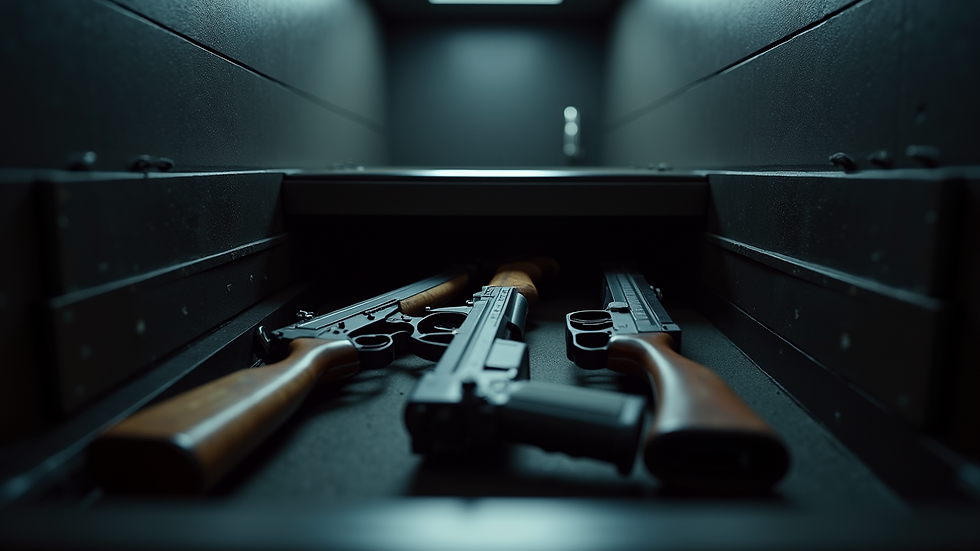Mastering Firearm Safety: A Comprehensive Guide
- Louis

- 5 days ago
- 4 min read
Owning a firearm is a serious responsibility. Whether you’re new to firearms or have been handling them for years, mastering firearm safety practices is essential. It’s not just about protecting yourself but also those around you. We want to share practical tips, clear explanations, and some personal insights to help you become a confident and responsible firearm owner. Let’s dive in and explore how to keep safety at the forefront every time you handle a gun.
Understanding the Basics of Firearm Safety Practices
Before you even pick up a firearm, it’s crucial to understand the fundamental safety rules. These are the building blocks that every responsible gun owner should live by:
Treat every firearm as if it is loaded. This mindset keeps you alert and cautious.
Never point the firearm at anything you do not intend to shoot. This rule prevents accidents.
Keep your finger off the trigger until you are ready to fire. This avoids unintentional discharges.
Be sure of your target and what is beyond it. Bullets can travel far and hit unintended objects or people.
These rules might sound simple, but they are powerful. Always remind yourself that complacency is the enemy of safety. Even experienced owners can make mistakes if they let their guard down.
Safe Storage: Protecting Your Firearm and Others
Safe storage is a critical part of firearm safety practices. It’s not just about keeping your gun out of reach of children or unauthorized users; it’s about preventing theft and accidental harm. Here are some tips we follow:
Use a gun safe or lockbox that is sturdy and secure.
Store firearms unloaded with ammunition kept separately.
Consider trigger locks or cable locks as an additional safety layer.
Educate family members about firearm safety and the importance of not touching guns without permission.
Safe storage is a simple step that can prevent tragic accidents. It’s a habit that every responsible owner should develop.

Firearm Safety Practices in Action: Handling and Maintenance
Handling your firearm safely goes beyond just the basics. It includes how you carry, clean, and maintain your gun. Here’s what we recommend:
Always check the firearm’s status when you pick it up. Open the action and visually inspect the chamber.
When cleaning, ensure the firearm is unloaded and pointed in a safe direction.
Use the correct cleaning tools and solvents to maintain your firearm’s reliability.
Regularly inspect your firearm for wear or damage. A well-maintained gun is a safer gun.
Carrying your firearm safely means using a proper holster that covers the trigger guard and fits your firearm well. Avoid carrying in a way that could cause accidental discharge or loss.
Practicing Safe Handling Every Time
Practice makes perfect. We encourage you to handle your firearm regularly in a controlled environment, like a shooting range, to build muscle memory for safe handling. This includes:
Drawing and holstering your firearm safely.
Practicing trigger discipline.
Simulating emergency situations where safety is paramount.
These exercises help you stay sharp and confident.

Are firearm safety courses worth it?
Absolutely. Taking a formal course can transform your understanding and skills. I’ve found that professional instruction fills in gaps that self-study or casual practice might miss. Here’s why I believe firearm safety courses are invaluable:
Expert guidance: Instructors provide hands-on training and immediate feedback.
Structured learning: Courses cover everything from basic safety to advanced handling techniques.
Legal knowledge: You’ll learn about Maryland’s specific firearm laws and regulations.
Confidence building: Knowing you’ve been trained properly reduces anxiety and increases responsible ownership.
If you’re serious about mastering firearm safety, I highly recommend enrolling in firearm safety courses. They offer personalized education tailored to your needs and skill level.
Common Mistakes and How to Avoid Them
Even with the best intentions, mistakes happen. Here are some common pitfalls and how to steer clear of them:
Assuming a firearm is unloaded: Always check yourself, don’t rely on others.
Pointing the muzzle carelessly: Remember, the safest direction is always downrange or at the ground.
Neglecting safe storage: This can lead to unauthorized access or accidents.
Skipping regular maintenance: Dirty or damaged firearms can malfunction dangerously.
Ignoring local laws: Stay informed about Maryland’s firearm regulations to avoid legal trouble.
By being aware of these mistakes, you can consciously avoid them and keep safety a priority.
Building a Safety Mindset for Everyday Ownership
Safety isn’t just a set of rules; it’s a mindset. We encourage you to think about firearm safety as part of your daily routine. Here are some ways to cultivate that mindset:
Stay informed: Keep up with new safety techniques and legal updates.
Practice regularly: The more you handle your firearm safely, the more natural it becomes.
Teach others: Share your knowledge with family and friends to promote a culture of safety.
Respect your firearm: Treat it as a powerful tool that demands your full attention.
When safety becomes second nature, you’ll feel more confident and prepared in any situation.
Mastering firearm safety practices is a journey, not a destination. By committing to these principles, you’re not only protecting yourself but also contributing to a safer community. Remember, responsible firearm ownership is about respect, knowledge, and constant vigilance. Stay safe out there!





Comments